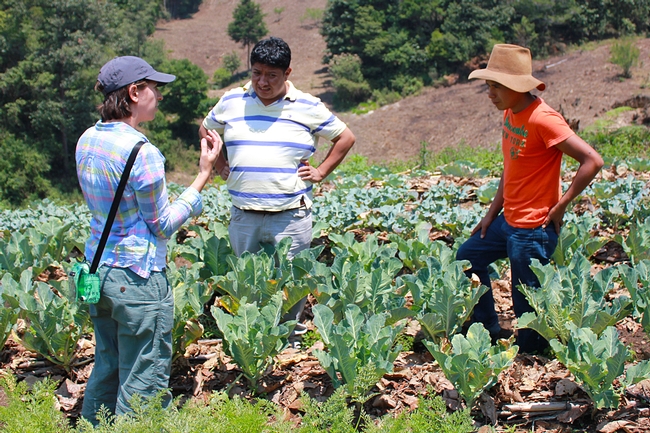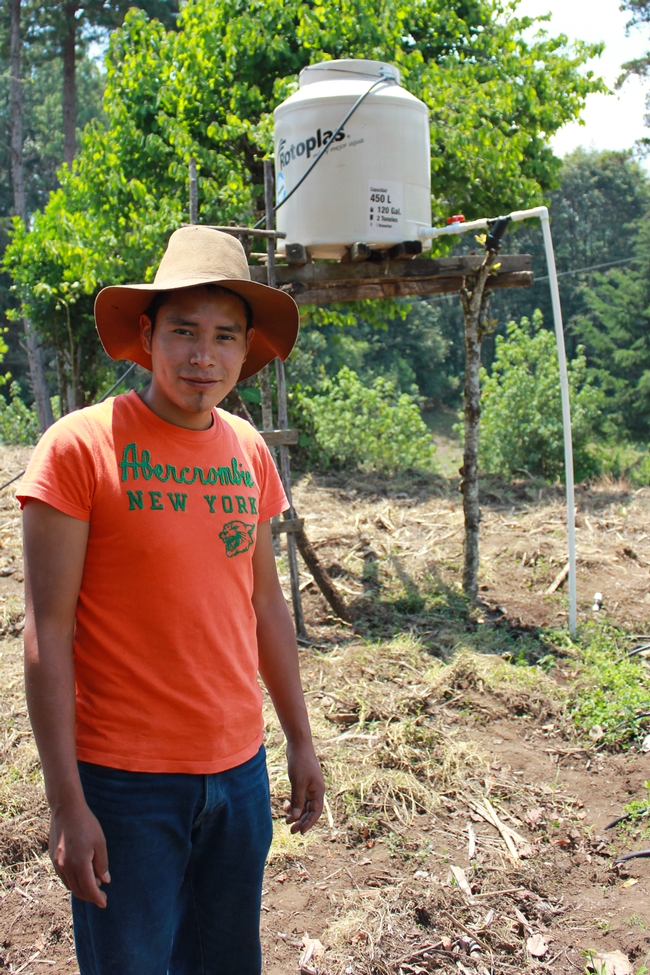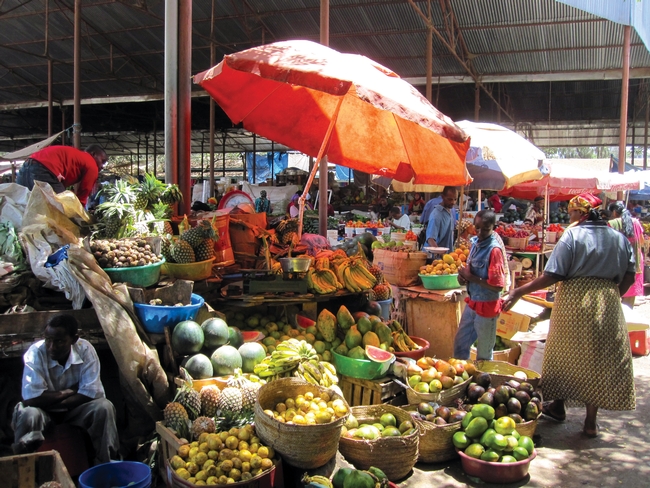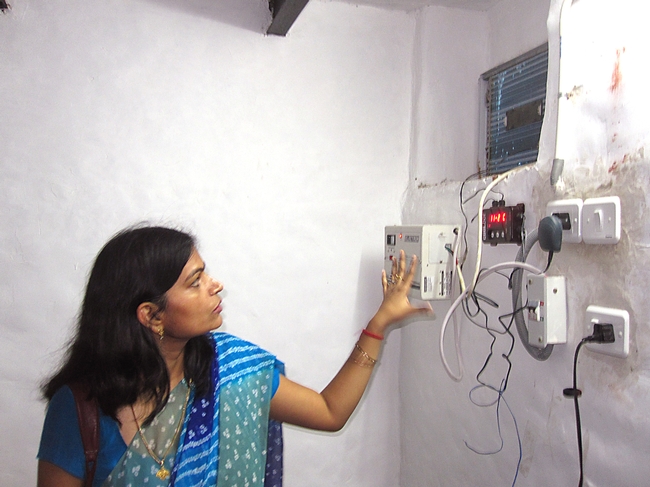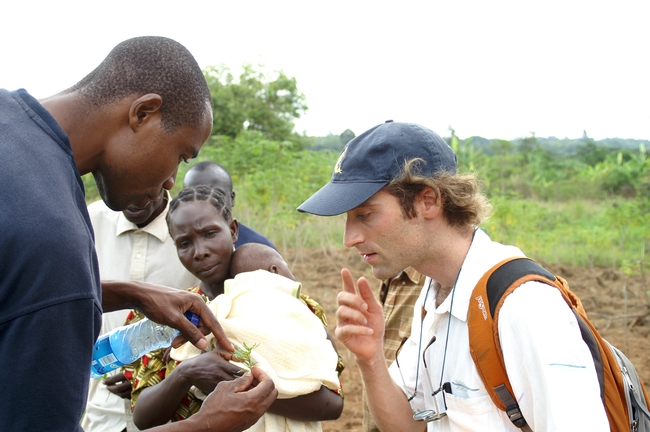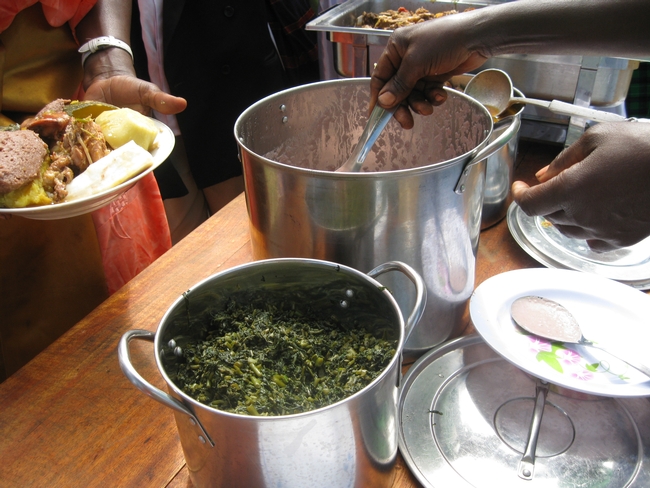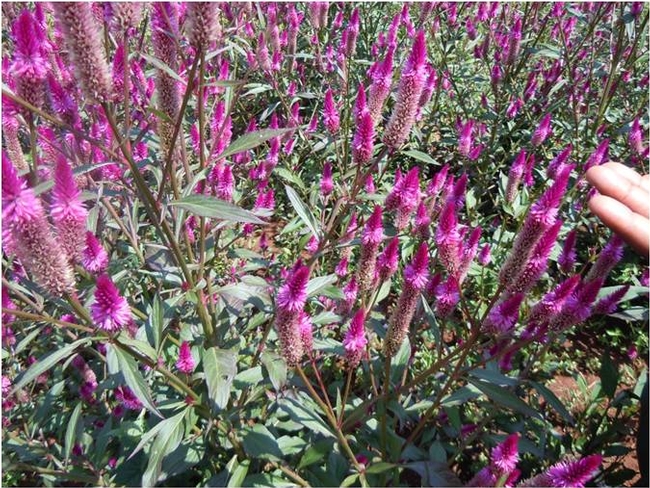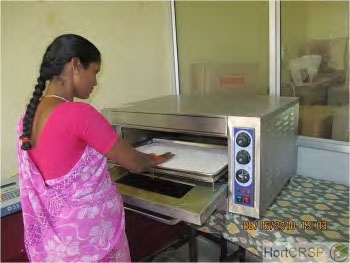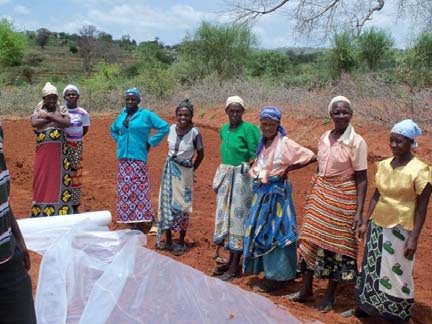Posts Tagged: Beth Mitcham
More irrigation for climate-smart farming and food security in Guatemala
Connecting 9,000 rural households in Guatemala with improved water management and climate-smart agriculture strategies is the goal of a new project led by a team at UC Davis, to ultimately increase food security and reduce poverty in Guatemala's Western Highlands.
“The opportunity to impact so many farmers' lives on this scale is exciting,” said Beth Mitcham, director of the Horticulture Innovation Lab and a UC Cooperative Extension specialist in the UC Davis Department of Plant Sciences. “We're taking lessons learned from our previous research — in Guatemala, Honduras and Cambodia — and building a team to help more small-scale farmers apply our findings and successfully use these innovative practices.”
The new project is part of the U.S. government's global hunger and food security initiative, Feed the Future. The project represents an additional $3.4 million investment in the UC Davis-led Horticulture Innovation Lab by the U.S. Agency for International Development's mission in Guatemala.
The project's international team also includes representatives from Kansas State University; North Carolina Agricultural and Technical State University; the Centro de Paz Bárbara Ford in Guatemala; Universidad Rafael Landívar in Guatemala; and the Panamerican Agricultural School, Zamorano, in Honduras.
“The learning shared between these three U.S. universities and the universities in Honduras and Guatemala will be enriching for all of the institutions involved,” said Manuel Reyes, research professor at Kansas State University who is part of the team. “I find it satisfying that these academic institutions will be investing intellectually in marginalized groups in Guatemala's Western Highlands — and in turn, learning from them too.”
Helping youth envision a future in agriculture
By partnering with local youth groups and agricultural schools, the team will better prepare students for jobs in commercial agriculture and agricultural extension with knowledge of climate-resilient conservation and water management practices.
“Our local team is training youth as entrepreneurs, to see agriculture as an economic opportunity instead of just back-breaking work,” said Meagan Terry, UC Davis junior specialist who is managing the project in Guatemala for the Horticulture Innovation Lab. “They can envision a future in agriculture, with innovative ways to create value-added products or grow high-value crops for niche markets.”
As rainfall patterns vary with climate change, farmers in this region are expected to face increased competition for water. Practices such as rainwater harvesting, drip irrigation and conservation agriculture will become more necessary for small-scale farmers.
Climate-smart lessons from conservation agriculture, drip irrigation
In previous research, the Horticulture Innovation Lab has found that combining drip irrigation with conservation agriculture practices can successfully grow vegetables on small plots of land, without significant yield reductions. These practices improve soil structure, moisture retention and soil health.
Additionally, women farmers who participated in the Horticulture Innovation Lab studies in Cambodia, Honduras and Guatemala favored using these practices for another important reason: reduced labor in relation to controlling weeds, vegetable bed preparation and manual watering.
“I dream for many women, youth and their families, that their lives will be better off because of 'MasRiego' and the science behind this work,” Reyes said. “As for the research, we are learning how to improve this suite of practices so they can be tailor fitted globally. I am convinced that if this picks up, steep sloping lands can be farmed with the soil quality not being degraded — but even being enriched.”
These lessons, as well as findings from the program's “Advancing Horticulture” report about horticultural sector growth in Central America, lay the foundation for this new project.
A previous version of this article was published by UC Davis News Service and on the Horticulture Innovation Lab blog.
Curious about partnering with the Horticulture Innovation Lab? The Horticulture Innovation Lab builds partnerships between agricultural researchers in the United States and researchers in developing countries, to conduct fruit and vegetable research that improves livelihoods in developing countries. The program currently has three research grant opportunities for U.S. researchers: one focused on tomatoes, another on apricots, and a third on integrated crop-livestock systems.
Hot days, cool rooms, tasty vegetables
I'll admit that one of my favorite things to do on a hot day is to walk into an air-conditioned room. That burst of cool air in those first moments can be so refreshing.
It turns out I'm not alone — fruits and vegetables like to be cool on hot days too.
Controlling temperature helps regulate the aging process of a fruit, along with its water loss and microorganism growth. Storing fruits and vegetables at their lowest safe temperatures means they taste better and last longer.
To help us know the best ways to store fresh produce at home, the UC Davis Postharvest Technology Center offers a free PDF poster Storing Fresh Fruits and Vegetables for Better Taste, which includes tips for different fruits and vegetables, from avocado to watermelon.
Knowing the right temperature is only part of the battle for farmers, who are responsible for the first links in the cold chain. Getting produce out of the sun and cool for storage can be a big challenge — and an expensive one.
But a farmer in New York, Ron Khosla, answered this challenge with a tool that can help make cooling produce less expensive for small-scale farmers. He created the CoolBot, a micro-controller that turns a well-insulated room with a regular air conditioner into a commercial cool room for storing fruits and vegetables.
Just as small-scale American farmers struggle with affordable cooling, so do smallholder farmers elsewhere in the world. Researchers with the Horticulture Collaborative Research Support Program (Horticulture CRSP) decided to test the CoolBot device, first at the UC Davis Student Farm and then with farmers in India, Honduras and Uganda.
Indeed, the CoolBot-equipped rooms worked, and the program is building more in Bangladesh right now. But there is a catch: Farmers must have access to reliable grid electricity for a cool room like this to work. To address this problem, the CoolBot in Uganda was powered with solar photovoltaic cells, but that led to another set of challenges — expensive equipment and fear of theft.
So how do you effectively cool vegetables, hot from a field, without grid electricity? A solution that is low-cost, effective and off-grid has not been found yet. In an effort to uncover such a solution, Horticulture CRSP will soon be launching a technology design competition that asks that very question. Can you answer this challenge?
Grad students head abroad to work with farmers
You’ve probably heard it millions of times in your lifetime, but it bears repeating: Not everyone has enough, good food to eat.
To that end, the Horticulture Collaborative Research Support Program at UC Davis builds global partnerships for fruit and vegetable research to improve livelihoods in developing countries.
Through Horticulture CRSP’s Trellis Fund, these students have been matched with organizations in Nepal, Uganda, Rwanda, Kenya, Tanzania, Honduras and Nicaragua to provide their agricultural expertise in assisting the organizations' projects with smallholder farmers.
Besides supporting local farmers in developing countries, the projects will also potentially infect students with an interest in international agricultural issues.
“With the Trellis Fund, our goal is to engage young people in an international experience — a chance to partner with a small organization working with real people with real needs and apply what they know about science,” said Beth Mitcham, UC Cooperative Extension specialist in the Plant Sciences Department at UC Davis and director of Horticulture CRSP. “For a small investment, we’re creating lasting relationships and perhaps changing the career path of a young person.”
Read our full press release for more details, or find out who is going where on our Trellis Fund page.
More African vegetables on more plates
What will be the new food frontier? An article in the Wall Street Journal with the headline “Next Stop for Food Fanatics: Africa” predicts adventurous American palates may soon be craving sub-Saharan cuisines.
Have you heard of these?
- Nakati (Solanum macrocarpon, S. aethiopicum) Also called African eggplant, some types of nakati are eaten for their leafy greens, while others are eaten for their fruit (which can look like a tomato or eggplant).
- Cowpea leaves (Vigna unguiculata) This plant produces black-eyed peas, but the greens of the plant can also be eaten as a vegetable.
- Bbuga (Amaranthus Gracecizans) You might know this plant by its common American name: pigweed.
- Doodo (Amaranthus Dubius) Like bbuga, this type of amaranth is eaten for its leaves in many parts of Africa. In North and South America, varieties of amaranth are usually used as a grain.
- Jjobyo (Gynandropsis Gynandra, Cleome gynandra) Also called spider plant.
Many of these indigenous vegetables are rich in micronutrients such as iron, vitamin A and vitamin B. When it comes to alleviating malnutrition in developing countries of eastern Africa, indigenous vegetables offer workable solutions because they are not only nutritious, but also familiar to the region’s eaters and farmers.
But research into these vegetables has often not been a priority, even among international development professionals. Markets for these vegetables are also largely undeveloped because they are widely considered subsistence crops, often grown in small garden plots by women for their own families. But growing these crops commercially can mean increased income for smallholder farmers and improved nutrition for consumers who crave traditional foods.
Recently U.S. researchers have been working with indigenous crops like these in east African countries — with funding and support from the Horticulture Collaborative Research Support Program (Horticulture CRSP), led by Beth Mitcham at UC Davis with funding from USAID. In Kenya, Tanzania and Zambia, Stephen Weller of Purdue University is leading a Horticulture CRSP research project on production practices, seed resources, postharvest handling, marketing and nutrition of varieties of amaranth, spider plant and African nightshade.
In Uganda, Kate Scow of UC Davis is partnering with local groups to try out a new model of extension while increasing production of indigenous greens, such as nakati, bbuga and jjobyo.
Take a look at this short video for a little more background:
Just as bok choy, an Asian vegetable, has become familiar to many American households, perhaps one day you’ll find nakati or another African leafy vegetable on your plate.
In the meantime, researchers with Horticulture CRSP are working to get more African leafy vegetables into the research agendas, fields, markets and plates of our counterparts in eastern Africa.
Read more abut Horticulture CRSP and its projects around the world at http://hortcrsp.ucdavis.edu.
Addressing nutrition and poverty through horticulture
Nutrition, food security and sufficient family incomes are challenges in many parts of the world. Half the world’s people live in rural areas in developing countries. Because hunger and malnutrition are often linked to poverty, providing economic opportunities through horticultural production not only helps family incomes, but also addresses food security and nutrition. Training women to produce and market horticultural crops in the developing world also helps provide a much-needed income stream for families with children.
UC Davis is addressing food security and economic development in Africa, Southeast Asia, Central America, and elsewhere, by coordinating an international horticulture program. The Horticulture Collaborative Research Support Program (Hort CRSP; pronounced "hort crisp") is one of 10 CRSP programs that focus on global food production and solving food and nutrition problems in developing countries. UC Davis leads the Hort CRSP, with funding support from the U.S. Agency for International Development (USAID).
Examples of projects conducted by researchers and educators throughout the world include:
- Inexpensive cold storage systems in rural, developing areas to prolong food longevity; see page 2
- Concentrated solar drying of fruits and vegetables in East Africa; see page 3
- Improving safety and quality of tomatoes in Nigeria; see page 3
- Smallholder flower production in Honduras for export markets; see page 3
The overarching goals of the Hort CRSP are to reduce poverty and improve nutrition and health of the rural poor, while improving the profitability and sustainability of horticulture in the developing world. Priorities in the Hort CRSP include gender equity, sustainable crop production, postharvest technology, food safety, market access, and financing. The program awards research funding in the U.S. and abroad to:
- Realize opportunities for horticultural development
- Improve food security
- Improve nutrition and human health
- Provide opportunities for income diversification
- Advance economic and social conditions of the rural poor, particularly women
Dr. Elizabeth Mitcham, UC Cooperative Extension specialist in the Department of Plant Sciences at UC Davis and director of the Hort CRSP, notes, “By harnessing the research, training, and outreach expertise of the land-grant universities in the U.S. to work with partners in developing countries, we can improve horticultural capabilities in much the same way that the land-grant system helped revolutionize American agriculture.”
In the three years since the program’s inception, several projects have been completed, and many are ongoing. The program’s website offers a plethora of information, along with newsletters that highlight individual projects.
The program also has a YouTube channel, with videos on Hort CRSP projects. Some of the videos are about projects that are especially important in developing countries, including:
- The TRELLIS project — bringing together graduate students and in-country development organizations; YouTube link
- Using cell phones to give real-time information to growers in rural areas of India; YouTube link
- Inexpensive cultivation practices for smallholder farmers; YouTube link
- Indigenous products increase incomes in Ghana; YouTube link
- Saving indigenous crop seeds in Southeast Asia for resource-poor farmers; YouTube link
UC Davis, ranked first in the U.S. on research related to agriculture, food science and nutrition, and plant and animal science, is positioned to serve global needs related to food and nutrition. Of the 10 CRSP programs administered by USAID, two of the programs are based at UC Davis — the Hort CRSP program, and the BASIS CRSP, which was highlighted in a recent Food Blog post and addresses financial issues related to agricultural productivity.


